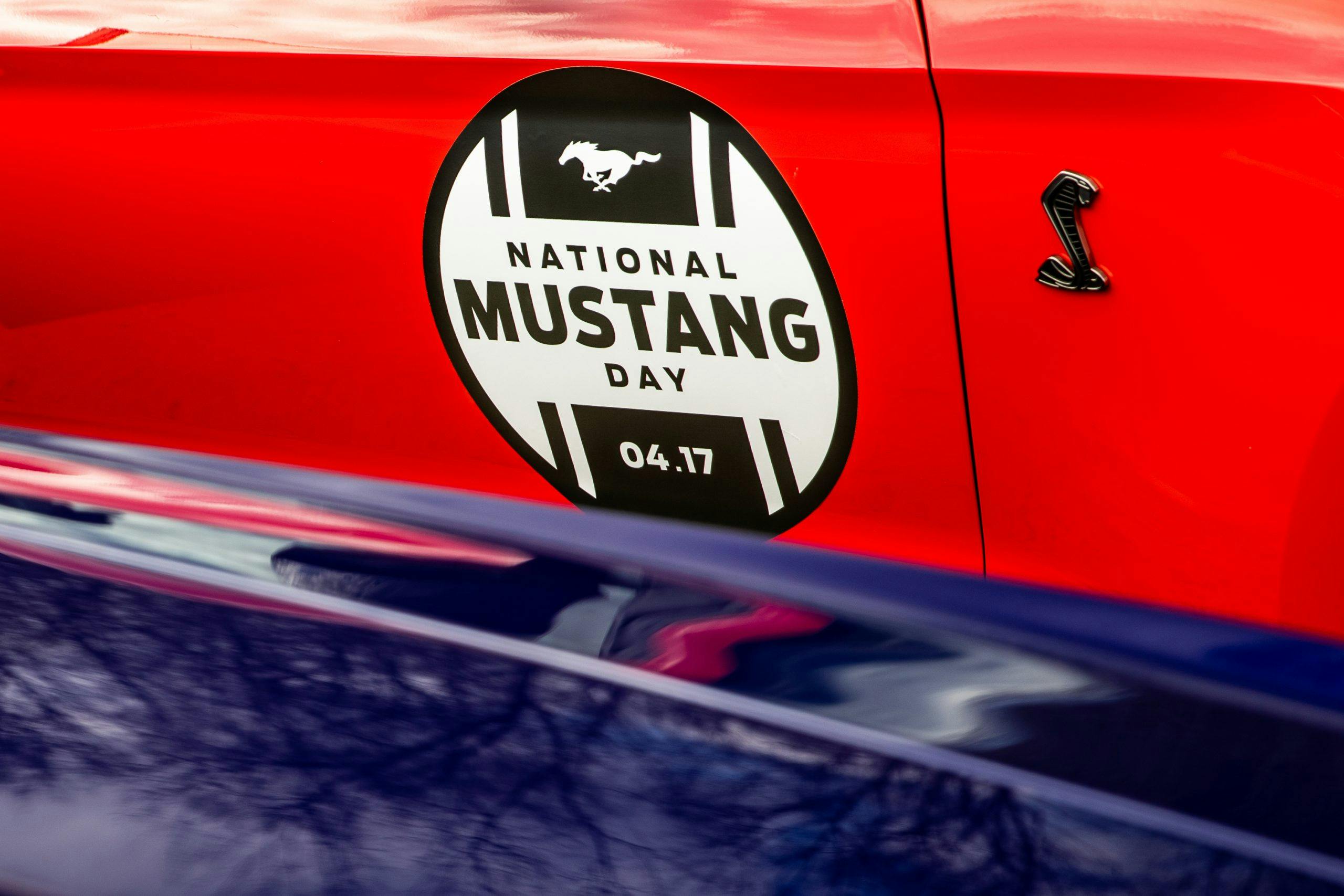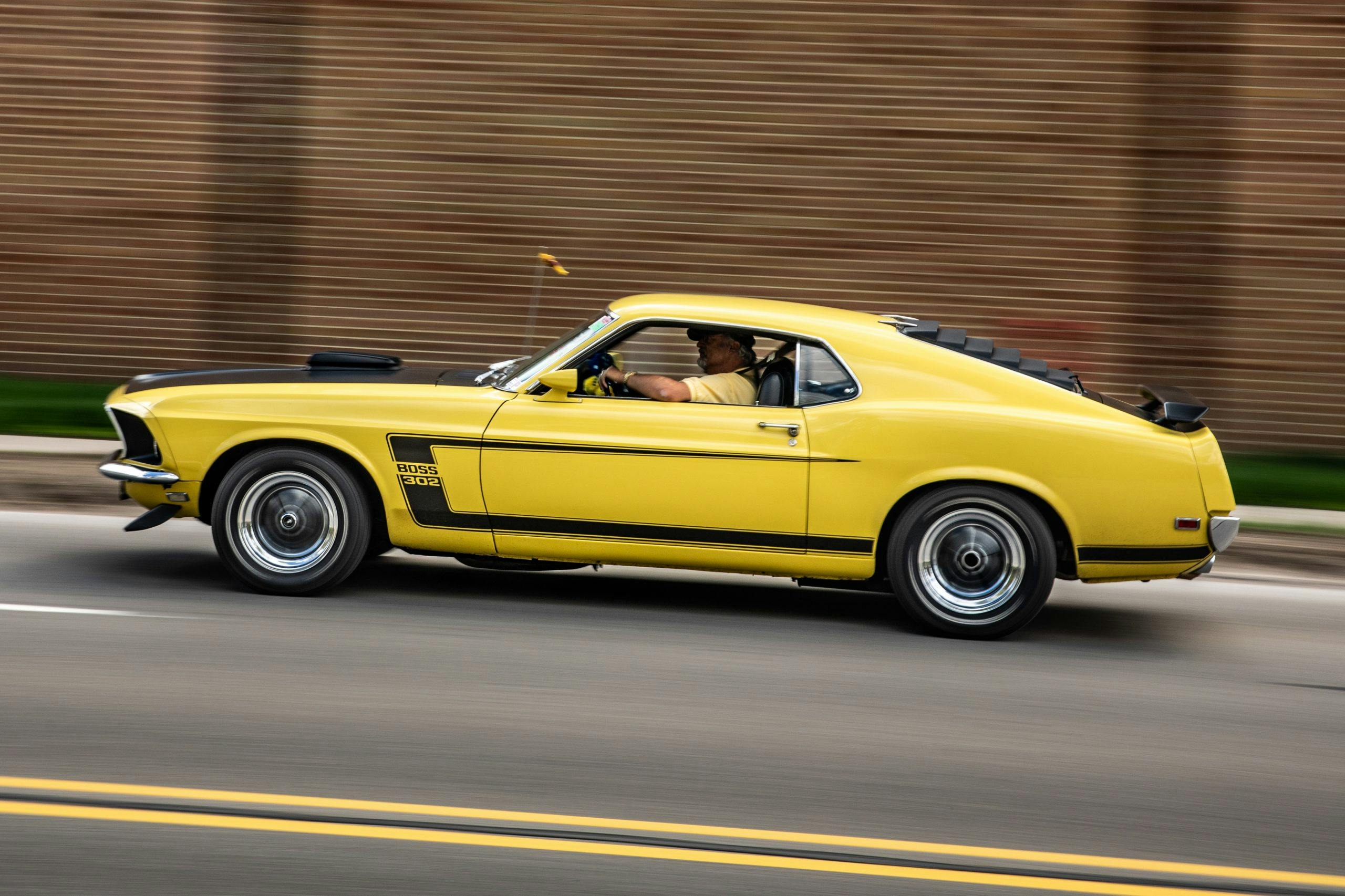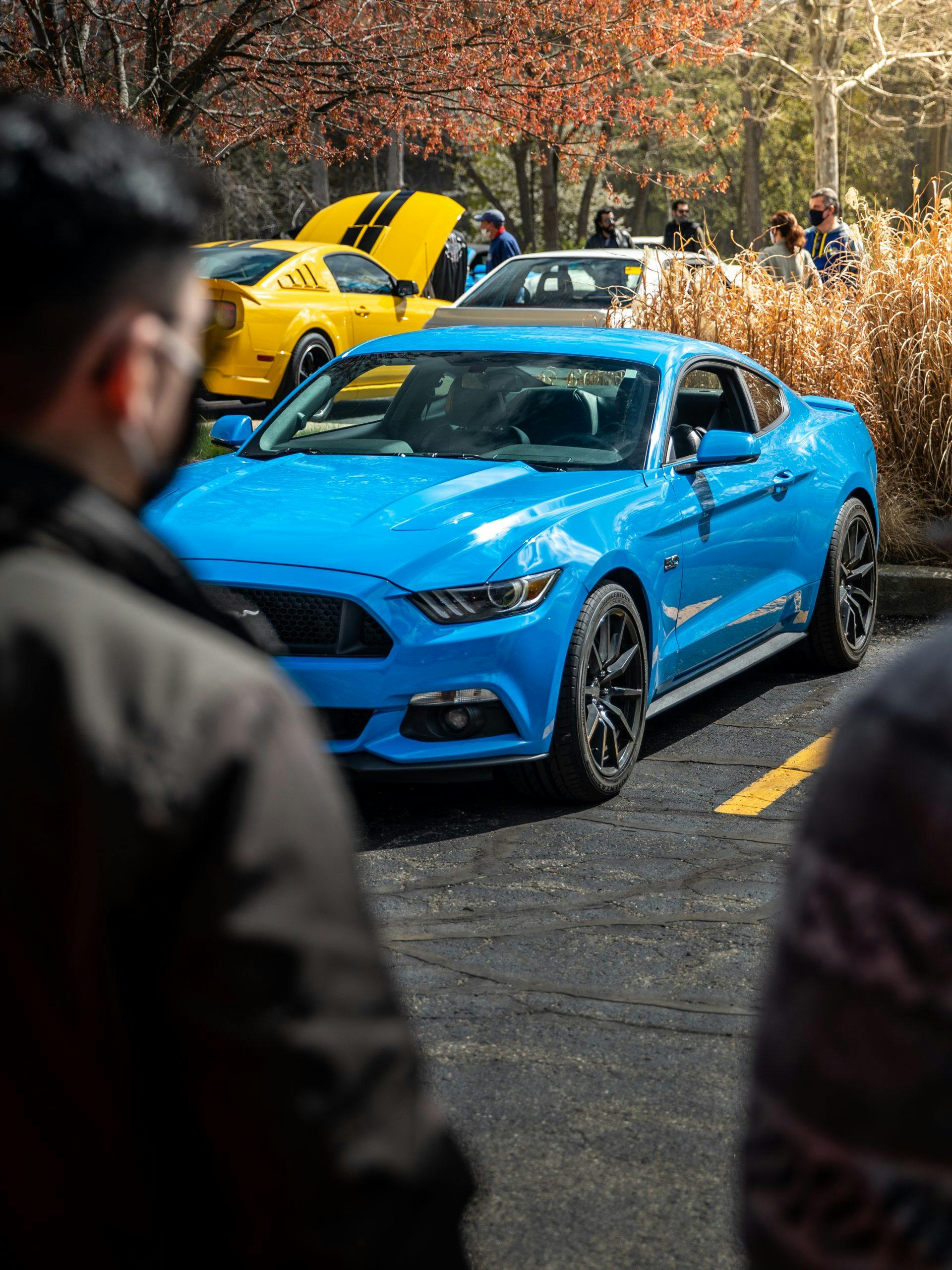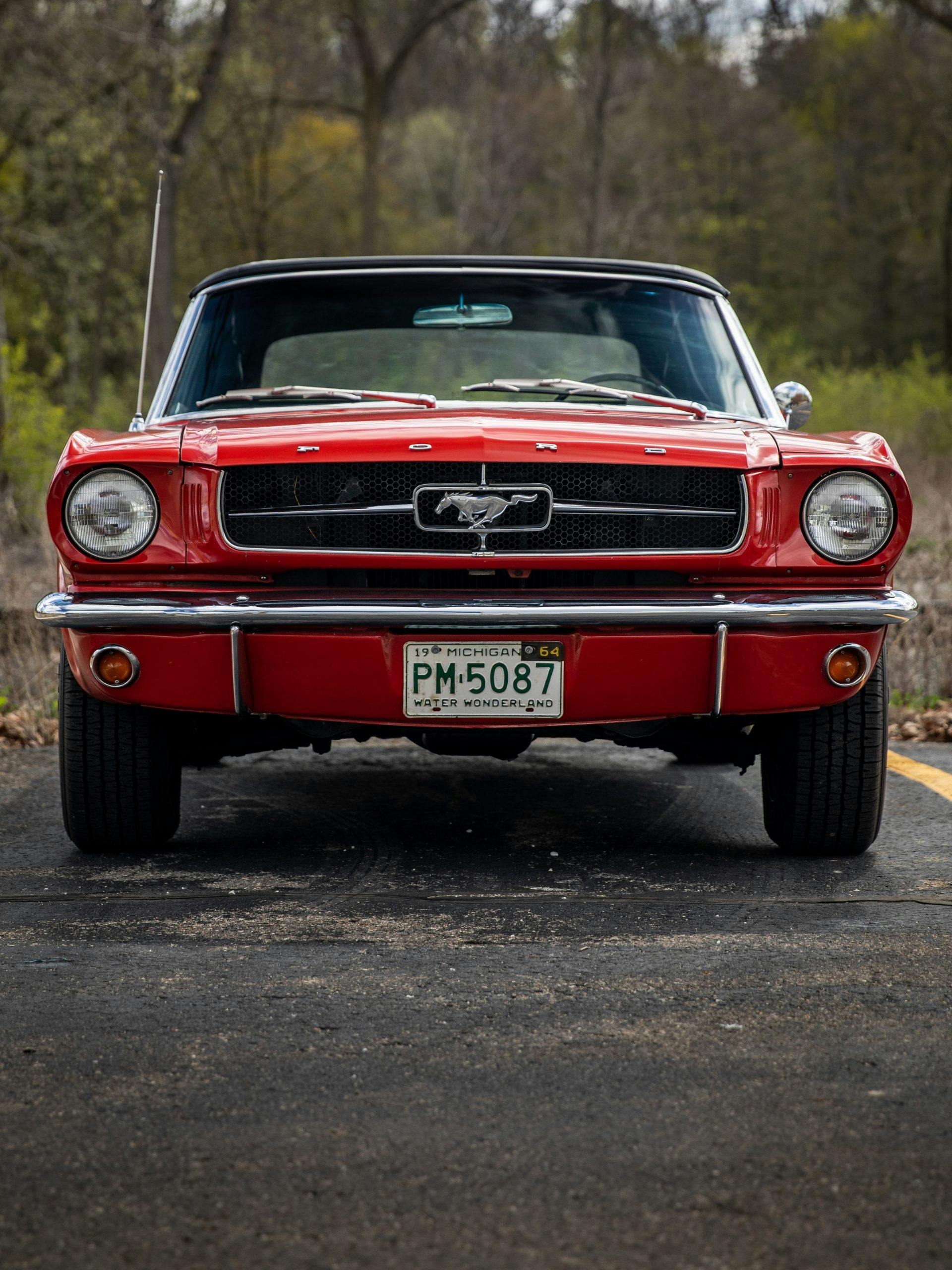Media | Articles
Michigan’s Global Mustang Day rally captured the colorful scope of Mustang culture
April 17 was National Mustang Day, and the weather was primed for celebration in Southeast Michigan. Under a remarkably well-behaved, blue sky, Mustang Owners Club members turned out in droves to cruise in a there-and-back rally that started at Michigan Central Station in Detroit. Between 150 and 200 total Mustangs from every generation—and restricted to club participants—represented nearly every performance tier in the model’s history.
We were honored to host a coffee stop on the rally at our editorial office in Ann Arbor. When our paved parking lot could not accommodate a single Mustang more, the incoming stream of pony cars began to divert into the pockmarked, gravel-strewn lot of the body shop across the street. The influx didn’t stop, however, and soon there was a colorful, burbling traffic jam at the office turn-in. Volunteers from SE Michigan’s Mustang Owners Club dispatched to wave drivers on to the third and final stage of the rally: Ford’s Garage in Dearborn.
Maximum-attack S550 GT500s shared the parking lot with inline-six, automatic-equipped first-gen cars. Mach 1s rolled in by the handful, including the original, the SN-95 version, and the all-new machine. (Ford generously loaned us a Grabber Yellow ’21 Mach 1 for the event, and we didn’t even manage to be the only such example in attendance.) Daily drivers mixed with track-dedicated restomods. Only one pony, however, was named Bucephalus.

“This is technically the only car I’ve owned with my name on the title,” says Laura Pasicznyk, a one-time professional cyclist who grew up outside of Philly and now works as an X-ray tech for the University of Michigan Hospital. She acquired the ’69 coupe in 1987 when her brother needed a parts car for his ’69 Mustang (and also needed his sister’s help to fund the purchase). The Mustang, which she dubbed Bucephalus, became her college car and, even after that, her only car. “I’ve never known life without a Mustang in the garage,” she says. “I feel very lucky.”
The coupe had the base 302 V-8, a three-speed auto, and no air conditioning. “It’s the workhorse,” Pasicznyk says. “The car has been to and from Canada, it’s been like five colors of green. We put studded tires on it. I drove in 10 inches of snow with that car, I’ve been in snow storms with that car.”
Marketplace
Buy and sell classics with confidence

When she made her living on two wheels, the Mustang held more than her bike: “My whole life was in that car.”
Her time with Bucephalus was hardly drama-free. To save money, Pasicznyk learned how to work on the drum brakes, adjust the points on the engine, and replace a countless number of power-steering hoses. “I don’t know how many times I broke down on the side of the highway, and the kindness of strangers … I don’t know how many people have helped me.”
After a string of unfulfilling office jobs simply to pay the bills, Pasicznyk landed in the healthcare industry on the suggestion of a neighbor. “I jumped with both feet without looking, which is usual for me, went to school, and became an X-ray tech.” Married, and with an independent income, Pasicznyk could finally restore Bucephalus the way she had determined to: with her own cash, and on her own time.
Her goals were to make the car both safe and fun to drive. Bucephalus now boasts front disc brakes, a four-barrel carb instead of the stock two-barrel, a Magnaflow dual exhaust, PerTronix electronic injection, and an Edelbrock manifold.

Among the younger demographics, at least at this particular event, there were several contemporary GT350s on the high end of the performance spectrum, with several more unassuming 5.0 GTs as well. The sunglasses-clad owner of a white Shelby GT350 confessed that this is his first outing with the Voodoo-powered machine. He struck up an animated conversation with Karl Woods, the driver of a 2017 Grabber Blue Mustang GT, who is about to graduate college and amid the throes of job-searching anxieties. Woods loves his five-oh (a recent upgrade from a ’17 EcoBoost in the same color) but his automotive interests aren’t limited to pony cars; for the past four years, he’s been restoring a 1980 Porsche 924 Turbo.

Woods and his friend Danny Perez, a vehicle development engineer for ZF and the owner of a 2013 California Special, at one point leaned over the gleaming engine bay of a 1969 Mustang fastback, enthralled.

“It’s a 434, but it’s not a stroker, it’s a revver,” said Steve Heinrich, a lanky plant manager who, in the ’90s, worked for Ford’s Europe-based F1 team designing the race cars’ electronic systems. He bought his Mustang in 1983 for $700 dollars and gleefully tells the story of how he needed an oxyacetylene torch and a hammer to take it on a test drive.
“It had been in a crash, and the front was so messed up that the front tires were squealing [when the seller was] pulling it out of the garage. ‘Do you have an oxyacetylene torch and a big hammer,’ I asked the guy. ‘Can I use them?’
“I wasn’t scared to do work in a driveway, I got under the car and pounded it back and aligned the front end enough to drive it. That’s how it started.”
In a pattern familiar to many, Heinrich soon found his time consumed by school, a wife, and kids. The car sat garaged for nearly 30 years, until 2015, when he decided to leverage his speed-shop connections and turn the fastback into a track car.

Today, little about the Mustang remains stock. That overhead-valve 434-cu-in mill—built out with forged internals including the crank, the rods, and the pistons—uses a Holley EFI system and is topped with a high-rise intake plenum from the same company. Output sits a little north of 600 hp, says Heinrich, and torque comes in at around 500 lb-ft. The engine exhales through long-tube headers and, since Heinrich wanted high-end horsepower rather than low-end torque, the dual-exhaust system uses an X-pipe rather than the stock H-pipe setup.

Power goes to the rear wheels via a Tremec six-speed dual-clutch unit rated for 1000 hp—just in case Heinrich decides to get creative later. To help the Mustang’s unibody construction handle that power, Heinrich also had Taylor-based Motor City Solutions, the shop largely responsible for the build, add frame extensions. Brakes are courtesy of AP racing and sit behind a set of Forgeline racing rims. Inside, Heinrich included a host of creature comforts—air-conditioning, Bluetooth, even a back-up camera—while maintaining a retro aesthetic.
This rally was Heinrich’s first real shakedown drive in the restomodded Mustang. When we followed up with him afterwards, he said the car “drove like a dream.”
Our winding journey back to Detroit took us along Edward N Hines Drive, which traces the Rouge River. Back at Ford’s Garage, the generous parking area accommodated the entire herd of Mustangs—including a brace of Mach-Es. Despite somewhat-awkward inclusion of the upstart EV in this rally, it’s clear that the enthusiast spirit among the Mustang community is thriving: The sheer range of cars, and the contingent of younger owners, testifies to that. From faithful daily drivers like Bucephalus to all-out restomods like Heinrich’s, Mustangs continue to bring all sorts of people together.
























































